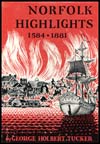Chapter 38
Landmark of Loveliness
St. Mary of the Immaculate Conception, Norfolk's oldest and most beautiful Catholic church, was one of the first churches in the United States to be named for the dogma of the Immaculate Conception. The belief that the Virgin Mary was free of original sin from the time of her conception was an ancient Catholic one, but it was not until December 8, 1854, that Pope Pius IX defined it as a dogma.
Two years later, on December 6, 1856, St. Patrick's, Norfolk's second Catholic church, was destroyed by fire. And when it was replaced by the present church at Holt and Chapel streets, the new church was consecrated on October 3, 1858, by the Right Reverend John McGill, bishop of the Diocese of Richmond, as St. Mary of the Immaculate Conception.
This history of Catholicism in Norfolk dates from August 1791, when the Reverend Jean Dubois, accompanied by several priests and other refugees, arrived in Norfolk from revolution-torn France. Three years later the "Roman Catholic Society of Norfolk Borough" bought the property on which St. Mary's now stands.
On this site a small chapel, Norfolk's first Catholic church, was built and a cemetery was established. This building gave the name Chapel Street to the then newly created thoroughfare that it faced. The simple chapel was replaced in 1842 by St. Patrick's, a handsome Greek Revival building with an imposing classic portico that stood on Holt Street just behind the present St. Mary's until it burned in 1856.
At the time of the fire, the Reverend Matthew O'Keefe was in charge of the Norfolk Catholic congregation. Father O'Keefe had endeared himself to the people of Norfolk for his heroic service during the 1855 yellow fever epidemic. And when he appealed for funds to rebuild his church, Catholics and Protestants worked untiringly to raise the money.
The total cost of the undertaking was sixty-five thousand dollars, and the congregation was left badly in debt. As a result, from 1858 to 1874, Father O'Keefe drew no salary while this debt was being reduced. The combined efforts of Father O'Keefe and his Norfolk friends and parishioners were so succesful, however, that the new church, the tall cross-crowned steeple of which is one of teh few remaining old landmarks on the downtown Norfolk skyline, was ready for dedication in less than two years.
Despite careful research, the name of the architect of St. Mary's has never been discovered, but whoever was responsible for its soaring architectural distinction did his work well. For none other than Ralph Adams Cram, the famous American architect and medievalist, who visited it in the early 1900s, called it "the best ante-bellum Gothic workmanship in the South."
Elegantly proportioned on the outside, St. Mary's has an interior that is breathtakingly beautiful. Delicate clustered columns crowned by elaborately fashioned capitals support its pointed arched Gothic roof, studded at intervals with symbolic bosses in gilded plaster.
Also notable are its fourteen Stations of the Cross painted in oil on copper by L. Chevot of Paris, the handsome choir loft at the back of the church containing its original tracker-type organ, the black and white marble paving of its aisles, and its handsome brass and marble baptismal font. The three altars of the church are also lovely, particularly the main altar, a marvelous Victorian sculptural fantasy of Carrara marble and Brazilian onyx.
But the main glory of St. Mary's is its magnificent stained-glass windows, regarded by many as the finest in Virginia.
Created specifically for the church by Mayer Studios of Munich, Germany, the windows were installed in 1918. And even on the darkest days they transform the interior of St. Mary's into a sanctuary of bejewelled wonder.
Chapter
39
Alexander Galt -- The Sculptor from Norfolk
Norfolk Highlights 1584 - 1881

See the "Table of Contents" for links to every chapter in Norfolk Highlights 1584 - 1881 by George Holbert Tucker.
